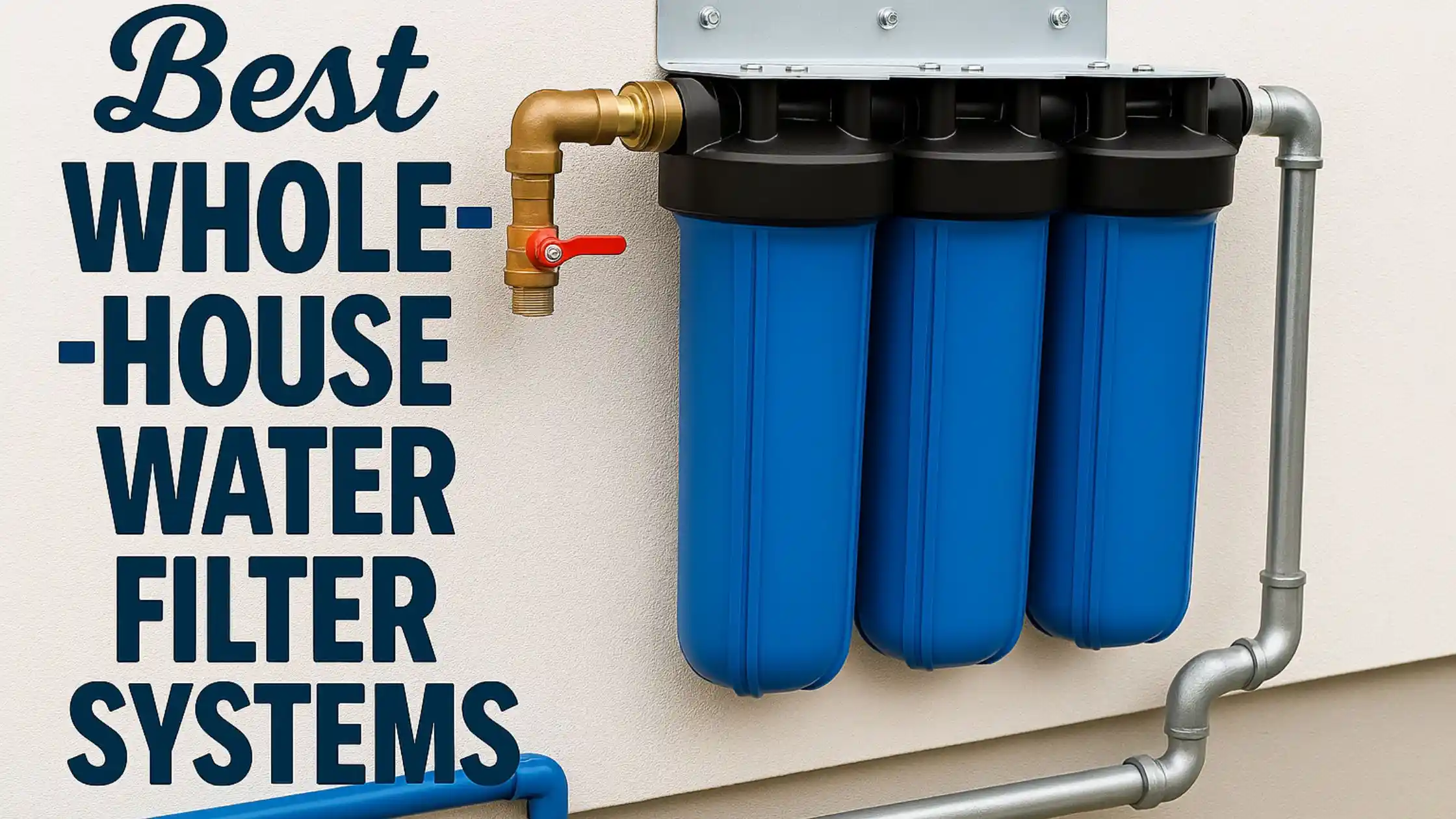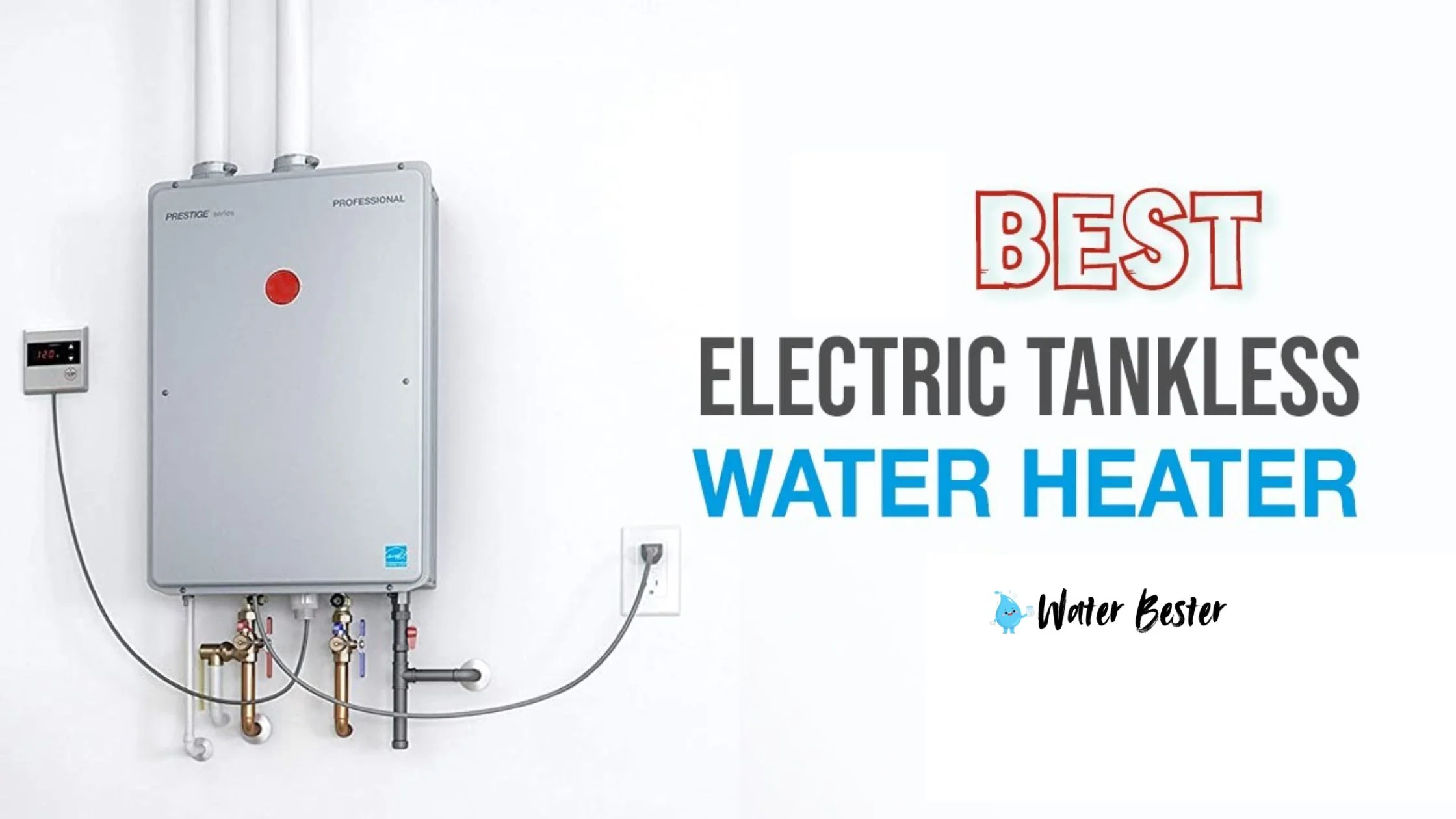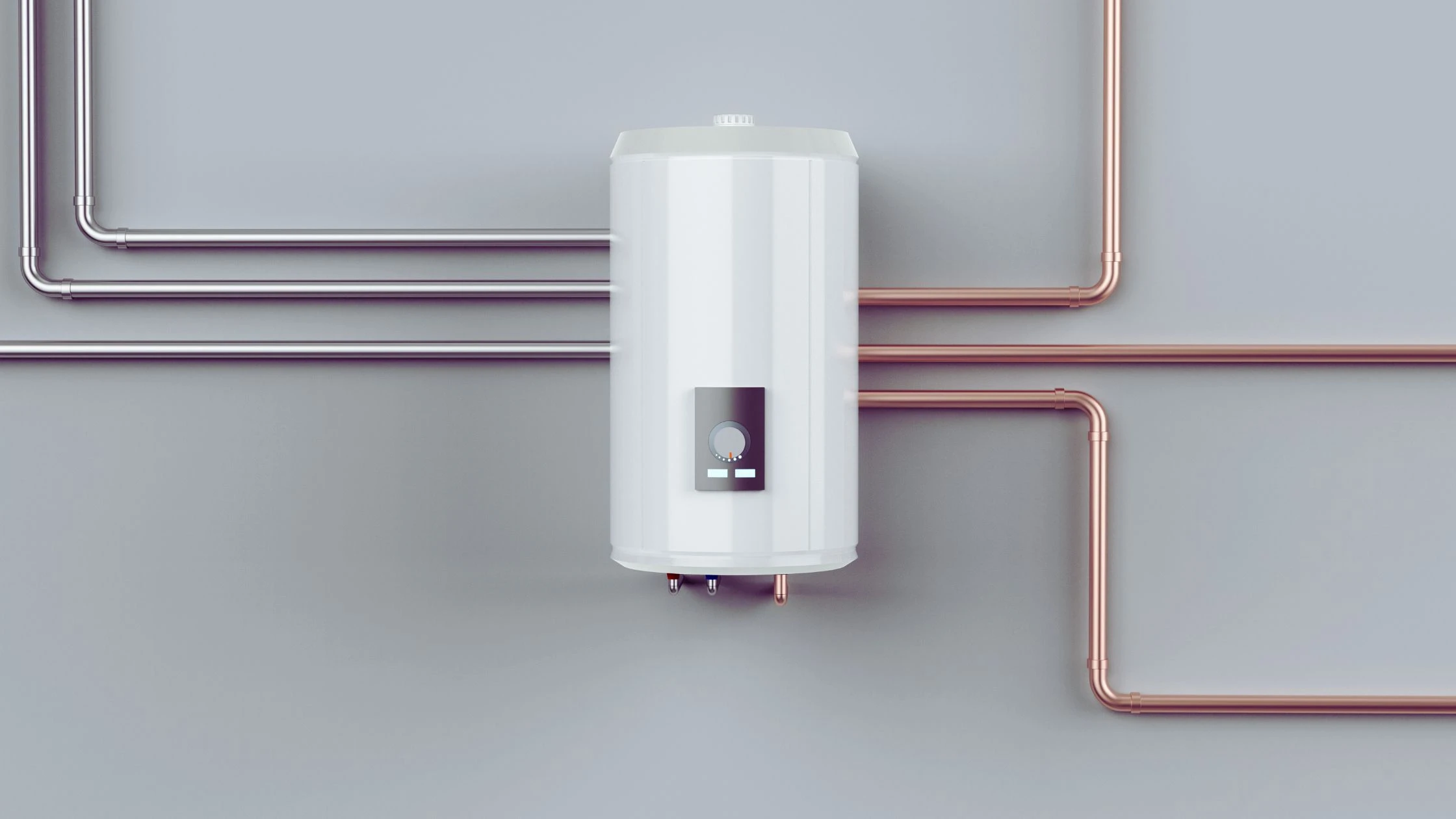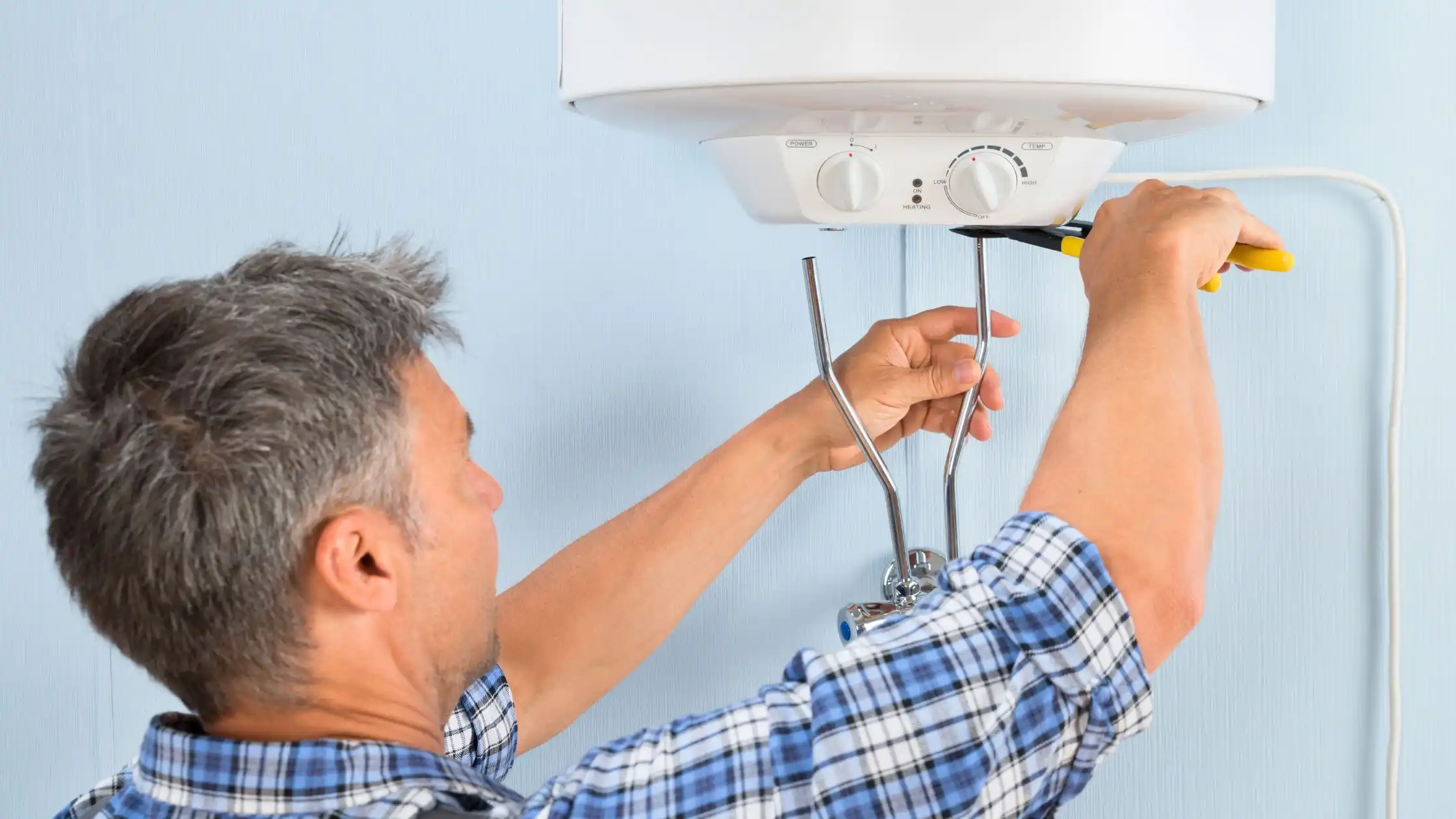Are you concerned about the quality of water flowing through every faucet in your home? You’re not alone. Millions of homeowners are turning to whole-house water filter systems to ensure clean, safe water for drinking, cooking, bathing, and laundry. As water quality concerns continue to rise nationwide, investing in a comprehensive filtration system has become less of a luxury and more of a necessity.
After testing dozens of systems and consulting with water quality experts, we’ve compiled this guide to the best whole-house water filter systems available in 2025. Whether you’re dealing with city water contaminants or private well challenges, this guide will help you decide to protect your family’s health and your home’s plumbing.
Quick Wins
- Best Overall Choice: SpringWell CF1
- Best for Well Water: SpringWell WS1
- Best for Hard Water: SpringWell SS1
- Best for Chemical Reduction: Aquasana Rhino
- Best Budget Option: Express Water
- Best Budget Well Water Option: iSpring WGB32BM
Understanding Whole-House Water Filter System
Unlike point-of-use filters that treat water at a single tap, whole-house systems (also called point-of-entry filters) treat water where it enters your home. This approach ensures every water source in your house—from kitchen faucets to shower heads—delivers filtered water.
These systems typically connect to your main water line before the water heater, removing contaminants before they can spread throughout your home’s plumbing system. The benefits extend beyond drinking water, protecting appliances from sediment damage and reducing chemical exposure during showers.
Most systems employ multiple filtration stages, each targeting specific contaminants. The complexity and effectiveness of these stages determine both the system’s price and performance.
Why Install a Whole-House Water Filter System?
Installing a whole-house water filter offers numerous advantages that point-of-use systems simply cannot match:
Comprehensive protection ensures every water source in your home delivers filtered water. This means you’re protected whether you’re drinking from the kitchen tap, showering in the bathroom, or washing clothes in the laundry room.
These systems can significantly extend the lifespan of water-using appliances like dishwashers, washing machines, and water heaters by preventing sediment buildup and scale formation. Many homeowners report reduced maintenance costs after installation.
For those with city water, whole-house filters remove chlorine and chloramine—disinfectants that, while necessary for public safety, can dry skin and hair and create unpleasant odors. Well water users benefit from protection against contaminants like iron, sulfur, and manganese that cause staining and odor issues.
Key Factors to Consider When Choosing a System
When selecting the ideal whole-house filter for your home, several critical factors should guide your decision:
1. Water Source and Quality
City water typically contains disinfectants and possible traces of pharmaceuticals or industrial chemicals. Well water often contains naturally occurring contaminants like iron, manganese, or sulfur. Obtaining a comprehensive water test before purchasing helps identify your specific filtration needs.
2. Flow Rate Requirements
Measured in gallons per minute (GPM), the flow rate determines how quickly water moves through your system. Most households require a minimum of 12-15 GPM to maintain adequate water pressure. Larger homes or properties with multiple bathrooms may need systems rated for 20+ GPM.
3. System Capacity and Lifespan
Filter capacity, measured in gallons or months of service, indicates how long filters will last before requiring replacement. Higher-capacity systems reduce maintenance frequency but typically cost more upfront.
4. Installation and Maintenance Complexity
Some systems require professional installation, while others are suitable for DIY homeowners with basic plumbing knowledge. Similarly, maintenance requirements vary significantly between models, affecting long-term ownership costs.
5. Filtration Technology
Different contaminants require different removal methods. Carbon filters excel at removing chlorine and organic compounds, while KDF media targets heavy metals. Sediment filters remove particles, and UV systems neutralize bacteria and viruses.
Best Whole-House Water Filter Systems of 2025
After extensive testing and research, these systems stand out for their performance, durability, and value:
1. Best Overall Choice: SpringWell CF1
The SpringWell CF System emerges as our top recommendation for 2025, continuing to impress with its exceptional filtration capabilities and innovative design features. The latest model incorporates improved filtration media that extends filter life by approximately 20% compared to previous versions while maintaining industry-leading contaminant removal rates.
The SpringWell CF System stands out for its exceptional chlorine and chemical removal capabilities, consistently eliminating up to 99.6% of common contaminants. Its long filter life significantly reduces maintenance frequency and long-term ownership costs, making it economical despite the higher initial investment. The system’s digital monitoring features take the guesswork out of maintenance schedules by alerting you precisely when attention is needed. Perhaps most impressively, the SpringWell maintains strong water pressure even in larger homes with multiple bathrooms, a common pain point with lesser systems.
Key Features
- Four-stage filtration process targeting chlorine, VOCs, pesticides, and sediment
- Self-adjusting backwash technology that conserves water
- Digital head unit for monitoring system performance
- 1,000,000-gallon capacity (approximately 10 years for average family)
- Maintains strong 12-15 GPM flow rate even in larger homes
Pros & Cons
- Experience cleaner, healthier water with a four-stage filtration system that effectively eliminates 99% of chlorine, chloramine, VOCs, PFAs, and other impurities.
- Designed with a 10-year or 1-million-gallon filter capacity, this system minimizes maintenance, making it virtually hassle-free.
- Can be paired with a water softener to address hard water concerns.
- Offers significant savings over time compared to traditional cartridge-based systems.
- Available in three models to suit homes of any size.
- Backed by an industry-leading lifetime warranty for peace of mind.
- While this system excels at removing contaminants, it is not designed to soften hard water on its own or filter out microbes, sulfur, iron, or manganese—substances typically found in well water.
The system’s coconut shell carbon media provides superior chlorine removal and requires less frequent replacement than standard carbon. Installation complexity is moderate, typically requiring 2-4 hours for an experienced DIY homeowner or professional plumber.
2. Best for Well Water: SpringWell WS1
Well water users face unique filtration challenges that the SpringWell WS System addresses comprehensively through its specialized multi-stage approach. This system effectively targets iron (up to 7 PPM), manganese, sulfur, and sediment—the most common well water contaminants.
The SpringWell WS System offers exceptional performance for well owners struggling with staining, odor, and taste issues. Its innovative air injection technology oxidizes dissolved contaminants without chemicals, while the substantial media bed provides superior filtration capacity compared to standard systems. The programmable head unit allows customization based on your specific water quality and usage patterns, optimizing both performance and backwash efficiency. Many users report immediate improvement in water clarity, elimination of sulfur odors, and dramatic reduction in fixture staining.
Key Features
- Air injection oxidation technology (AIO) requires no chemicals
- Removes up to 7 PPM iron, 1 PPM manganese, and 8 PPM hydrogen sulfide
- Automatic backwashing at programmable intervals
- Bluetooth-enabled control head with smartphone monitoring
- Robust 10-year warranty with excellent customer support
Pros & Cons
- Eliminates rust staining, metallic taste, and sulfur odors
- No chemicals or salt required for operation
- Single-tank design conserves installation space
- Maintains strong water pressure (12-15 GPM)
- Automated operation requires minimal oversight
- Addresses multiple well water contaminants simultaneously
- May require pre-filtration in extremely sediment-heavy wells
- Higher initial investment than basic filtration
The system uses a carefully engineered air pocket to oxidize dissolved iron and sulfur compounds, transforming them into filterable particles that are then captured by the specialized media bed. This approach eliminates the need for chemical injection while effectively addressing the most common well water complaints.
3. Best for Hard Water: SpringWell SS1
The SpringWell SS1 Salt-Based Water Softener has emerged as the premier solution for homes battling serious hardness issues, providing comprehensive mineral management without sacrificing water pressure.
Key Features
- Precision digital metering for salt and water efficiency
- Adjustable hardness settings for customized treatment
- High-capacity resin designed for extended service life
- Available in multiple sizes based on household needs (1-3, 4-6, or 7+ bathrooms)
- Bluetooth connectivity with smartphone app for system monitoring
Pros & Cons
- Effectively eliminates hard water scale and buildup
- Extends appliance lifespan by preventing mineral deposits
- Responsive customer support with installation assistance
- Six-month money-back guarantee with lifetime warranty
- Digital monitoring prevents salt wastage
- Requires ongoing salt purchases and loading
- Produces wastewater during regeneration cycles
- Needs periodic cleaning of brine tank
Unlike salt-free conditioners that prevent new scale, the SS1 removes calcium and magnesium through ion exchange, providing a comprehensive solution for homes with moderate to severe hardness problems. The system’s demand-based regeneration conserves both salt and water compared to timer-based competitors.
4. Best for Chemical Reduction: Aquasana Rhino
The Aquasana Rhino system removes a broad spectrum of chemicals, making it ideal for urban households concerned about industrial contaminants or pharmaceutical residues in municipal water supplies.
The Aquasana Rhino excels specifically at tackling complex chemical contaminants, particularly beneficial for homes in areas with industrial activity or aging municipal infrastructure. Its salt-free technology effectively prevents scale buildup while preserving the beneficial minerals that traditional softeners remove. When properly sized, the system creates minimal pressure drop, ensuring comfortable water flow throughout the home. The optional UV purification stage provides exceptional protection against microbiological threats, an important consideration for families with young children or immunocompromised members.
Key Features
- Salt-free water conditioner prevents scale without removing beneficial minerals
- Innovative dual-tank design maximizes contaminant removal
- UV filter option for bacteria protection (recommended for well water users)
- 1,000,000-gallon capacity or approximately 10 years of service
- Includes professional grade installation kit
Pros & Cons
- Exceptional performance against complex chemical contaminants
- Salt-free technology prevents scale while preserving beneficial minerals
- Minimal pressure drop when properly sized for your home
- Optional UV purification stage eliminates bacteria and viruses
- Comprehensive installation kit includes everything needed
- 10-year limited warranty provides excellent coverage
- More expensive than standard carbon-based systems
- Replacement filters for premium components can be costly
The Rhino’s multi-stage approach tackles chlorine, pesticides, herbicides, and industrial solvents, while its salt-free conditioning technology prevents scale buildup without the drawbacks of traditional water softeners. The system maintains healthy mineral content in your water while removing harmful contaminants.
5. Best Budget Option: Express Water Heavy Metal Whole House Filter
Despite its relatively affordable price point, the Express Water system delivers impressive performance for households dealing with heavy metal concerns such as lead, mercury, or copper.
Key Features
- Three-stage filtration targeting sediment, heavy metals, and chemicals
- Clear housing allows visual inspection of filter condition
- Simple filter replacement process requiring no special tools
- 100,000-gallon capacity (approximately 1 year for an average family)
- Maintains 15 GPM flow rate suitable for homes with up to 3 bathrooms
Pros & Cons
- Excellent value for performance delivered
- Easy visual monitoring of filter condition
- Simple DIY installation and maintenance
- Effective removal of heavy metals and sediment
- Minimal pressure drop across system
- More frequent filter replacements than premium systems
- Less comprehensive contaminant removal than multi-stage systems
- No digital monitoring capabilities
- Housing durability concerns in some installations
- Limited warranty compared to premium options
The system’s KDF-55 media specifically targets heavy metals, while activated carbon removes chemical contaminants and improves taste. While filter replacements are required more frequently than premium systems, the straightforward design makes maintenance a 15-minute task for most homeowners.
6. Best Budget Well Water Option: iSpring WGB32BM
For well owners seeking a more economical solution to moderate contamination issues, the iSpring WGB32BM delivers respectable performance without the premium price tag.
Key Features
- Three-stage design with 5-micron sediment pre-filter
- Iron and manganese removal up to 3 PPM
- Carbon block filtration for chemical contaminants and taste improvement
- 100,000-gallon capacity (approximately 1 year for an average family)
- Big Blue 4.5″ x 20″ filter housings for maximum media contact time
Pros & Cons
- Excellent value for performance delivered
- Effectively addresses moderate iron and manganese issues
- Improves taste and eliminates odors
- Transparent filter housings for visual monitoring
- Good removal of chlorine and common chemicals
- Less effective against severe contamination than AIO systems
- More frequent filter replacements than premium alternatives
- Lower flow rate under heavy demand
- Less effective against hydrogen sulfide than dedicated systems
- Limited warranty compared to premium options
The system’s manganese dioxide media effectively oxidizes dissolved iron for removal, while the carbon block stage eliminates the “rotten egg” odor caused by hydrogen sulfide. For well owners struggling with staining or odor issues, this system provides targeted filtration at a reasonable price point.
Comparison Table: Best Whole-House Water Filters 2025
| System | Best For | Flow Rate | Capacity | Filter Life | Key Technology |
|---|---|---|---|---|---|
| SpringWell CF | Overall Performance | 12-15 GPM | 1,000,000 gal | 8-10 years | Catalytic carbon |
| SpringWell WS1 | Well water treatment | 12-15 GPM | Varies | 5-7 years | Air injection oxidation |
| SpringWell SS1 | Hard water treatment | 11-20 GPM | Varies | 8-10 years | Ion exchange resin |
| Aquasana Rhino | Chemical Reduction | 7-10 GPM | 1,000,000 gal | 10 years | Dual-tank design |
| Express Water | Budget-conscious | 15 GPM | 100,000 gal | 1 year | KDF-55 media |
| iSpring WGB32BM | Budget well water | 15 GPM | 100,000 gal | 1 year | Manganese dioxide |
Installation Considerations
Installing a whole-house water filter typically requires moderate plumbing knowledge and proper tools. While many homeowners complete DIY installations, several factors warrant consideration:
1. Space Requirements
Most systems require at least 4 square feet of wall space near your main water entry point and sufficient clearance for filter changes. Bypass valves should be installed to allow for system maintenance without disrupting water service.
2. Professional vs. DIY Installation
Professional installation typically costs $300-$800, depending on your location and plumbing configuration. This investment often includes system optimization and may be required to maintain manufacturer warranties. For DIY installations, carefully follow manufacturer instructions regarding pipe configurations and water flow direction.
3. Permit Requirements
Some municipalities require permits for significant plumbing modifications. Check local regulations before beginning installation to avoid potential compliance issues or complications when selling your home.
The majority of installation difficulties arise from improper measurement or insufficient preparation of the installation area. Carefully measure your available space and existing pipe configuration before purchasing a system to avoid compatibility problems.
Maintenance Requirements and Costs
Long-term satisfaction with your whole-house filter depends largely on adhering to proper maintenance schedules:
1. Filter Replacement Schedules
Entry-level systems typically require filter changes every 3-6 months, while premium systems may operate effectively for 5-10 years before media replacement. Following manufacturer recommendations prevents diminished performance and potential system damage.
2. Ongoing Costs
Annual maintenance costs range from $150-$300 for systems requiring frequent filter changes to as little as $50-$100 per year for high-capacity systems. When calculating total ownership costs, factor in both purchase price and anticipated maintenance expenses over your expected ownership period.
3. DIY Maintenance Tips
Regularly check pressure gauges (if equipped) to monitor filter condition. Declining water pressure often indicates sediment buildup, requiring filter replacement. Installing pressure gauges before and after your system provides valuable diagnostic information.
Final Thoughts: Making Your Decision
Selecting the ideal whole-house water filter system involves balancing initial cost against long-term performance and maintenance requirements. For most households, investing in a higher-quality system pays dividends through extended service life and improved water quality.
Begin your selection process by obtaining a comprehensive water test to identify your specific contaminant concerns. Focus on systems designed to address your particular water quality issues rather than marketing claims about contaminant removal percentages that may not apply to your situation.
Consider your household’s water usage patterns when evaluating flow rate requirements. A system that restricts water pressure will become a daily frustration regardless of its filtration capabilities.
Finally, factor in both purchase price and anticipated maintenance costs when comparing systems. The least expensive option rarely provides the best long-term value, while the most expensive system may include features unnecessary for your specific water quality concerns.
With the right whole-house water filter system, you’ll enjoy the peace of mind that comes from knowing every drop of water in your home is clean, safe, and appliance-friendly. The investment pays returns not just in water quality but in protected plumbing infrastructure and potentially improved health outcomes for your entire household.












